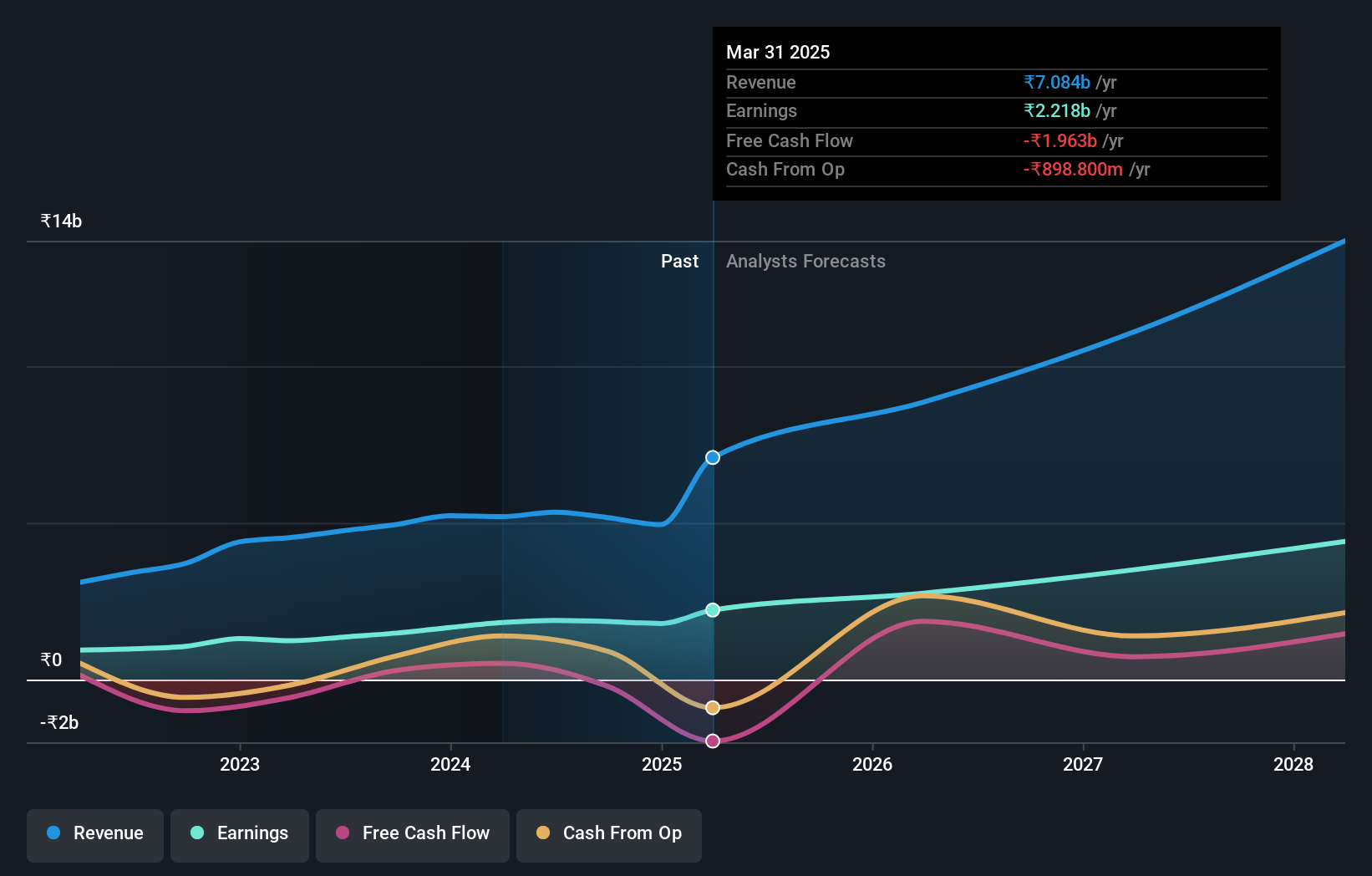- India
- /
- Aerospace & Defense
- /
- NSEI:DATAPATTNS
Data Patterns (India) Limited's (NSE:DATAPATTNS) largest shareholder, CEO Srinivasagopalan Rangarajan sees holdings value fall by 4.0% following recent drop

Key Insights
- Data Patterns (India)'s significant insider ownership suggests inherent interests in company's expansion
- The top 5 shareholders own 50% of the company
- Institutions own 17% of Data Patterns (India)
To get a sense of who is truly in control of Data Patterns (India) Limited (NSE:DATAPATTNS), it is important to understand the ownership structure of the business. We can see that individual insiders own the lion's share in the company with 54% ownership. That is, the group stands to benefit the most if the stock rises (or lose the most if there is a downturn).
As a result, insiders as a group endured the highest losses after market cap fell by ₹6.9b.
Let's delve deeper into each type of owner of Data Patterns (India), beginning with the chart below.
See our latest analysis for Data Patterns (India)

What Does The Institutional Ownership Tell Us About Data Patterns (India)?
Institutional investors commonly compare their own returns to the returns of a commonly followed index. So they generally do consider buying larger companies that are included in the relevant benchmark index.
We can see that Data Patterns (India) does have institutional investors; and they hold a good portion of the company's stock. This suggests some credibility amongst professional investors. But we can't rely on that fact alone since institutions make bad investments sometimes, just like everyone does. When multiple institutions own a stock, there's always a risk that they are in a 'crowded trade'. When such a trade goes wrong, multiple parties may compete to sell stock fast. This risk is higher in a company without a history of growth. You can see Data Patterns (India)'s historic earnings and revenue below, but keep in mind there's always more to the story.

We note that hedge funds don't have a meaningful investment in Data Patterns (India). With a 23% stake, CEO Srinivasagopalan Rangarajan is the largest shareholder. With 19% and 3.3% of the shares outstanding respectively, Rekha Rangarajan and Singapore are the second and third largest shareholders. Interestingly, the second-largest shareholder, Rekha Rangarajan is also Senior Key Executive, again, pointing towards strong insider ownership amongst the company's top shareholders.
Our research also brought to light the fact that roughly 50% of the company is controlled by the top 5 shareholders suggesting that these owners wield significant influence on the business.
While it makes sense to study institutional ownership data for a company, it also makes sense to study analyst sentiments to know which way the wind is blowing. There are a reasonable number of analysts covering the stock, so it might be useful to find out their aggregate view on the future.
Insider Ownership Of Data Patterns (India)
The definition of company insiders can be subjective and does vary between jurisdictions. Our data reflects individual insiders, capturing board members at the very least. Management ultimately answers to the board. However, it is not uncommon for managers to be executive board members, especially if they are a founder or the CEO.
Most consider insider ownership a positive because it can indicate the board is well aligned with other shareholders. However, on some occasions too much power is concentrated within this group.
Our most recent data indicates that insiders own the majority of Data Patterns (India) Limited. This means they can collectively make decisions for the company. Given it has a market cap of ₹168b, that means insiders have a whopping ₹91b worth of shares in their own names. Most would be pleased to see the board is investing alongside them. You may wish to discover if they have been buying or selling.
General Public Ownership
The general public-- including retail investors -- own 25% stake in the company, and hence can't easily be ignored. This size of ownership, while considerable, may not be enough to change company policy if the decision is not in sync with other large shareholders.
Next Steps:
It's always worth thinking about the different groups who own shares in a company. But to understand Data Patterns (India) better, we need to consider many other factors. Case in point: We've spotted 2 warning signs for Data Patterns (India) you should be aware of, and 1 of them doesn't sit too well with us.
Ultimately the future is most important. You can access this free report on analyst forecasts for the company.
NB: Figures in this article are calculated using data from the last twelve months, which refer to the 12-month period ending on the last date of the month the financial statement is dated. This may not be consistent with full year annual report figures.
New: Manage All Your Stock Portfolios in One Place
We've created the ultimate portfolio companion for stock investors, and it's free.
• Connect an unlimited number of Portfolios and see your total in one currency
• Be alerted to new Warning Signs or Risks via email or mobile
• Track the Fair Value of your stocks
Have feedback on this article? Concerned about the content? Get in touch with us directly. Alternatively, email editorial-team (at) simplywallst.com.
This article by Simply Wall St is general in nature. We provide commentary based on historical data and analyst forecasts only using an unbiased methodology and our articles are not intended to be financial advice. It does not constitute a recommendation to buy or sell any stock, and does not take account of your objectives, or your financial situation. We aim to bring you long-term focused analysis driven by fundamental data. Note that our analysis may not factor in the latest price-sensitive company announcements or qualitative material. Simply Wall St has no position in any stocks mentioned.
About NSEI:DATAPATTNS
Data Patterns (India)
Provides defense and aerospace electronics solutions in India.
Flawless balance sheet with high growth potential.
Market Insights
Community Narratives


